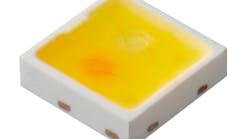The articles are Cree breaks efficacy records for power LED and Cree R&D achieves 1,000 lm from single-chip LED (update).
We think the articles give an accurate version of the results reported, and we spoke with Cree to better understand what has been achieved.
However, there is a problem in comparing these results to others previously published either by Cree or by its competitors. One issue relates to chip size. Cree EZBright chips are 980 micron (0.98 mm) per edge. Lumileds, when it reported a result of 115 lm/W earlier this year, specified that it was using a 1 x 1 mm chip. The Cree chip used in the company's most recent announcements has an unspecified size of between 1 and 2 mm per edge.
This issue is that a larger chip, driven at the same current, has lower current density and therefore higher efficacy (other things being equal).
Another issue is whether the data is measured instantaneously or, alternatively, after the device has been switched on for sufficient time to reach thermal equilibrium. In the latter case, the LED junction temperature will be higher so the luminous flux (lumens) will be lower. Cree gave us the relevant information in each case.
What does this tell us? For one, there are so many variables that if you see two sets of results of this type there is very little chance you will be able to make an "apples to apples " comparison. Which of course makes it very difficult for companies to claim record performance.
Does anyone care who has the "record" anyway? These are R&D results, not production devices that are available in high volume with proven reliability. Surely that is most important to people that buy and use the devices?
Perhaps financial analysts and investors care most. Cree's second announcement (the efficacy record) came out on Thursday September 13th, and on the next day the company's share price rose from around $27 to $29. I don't have enough financial knowledge to understand if these events are related - although Forbes still thinks GE has plans to buy Cree - see article.
Don't misunderstand me, Cree's results are hugely impressive, and this is not meant to be a criticism of them. But they need to be understood and placed in context. The point is that comparing different sets of results for LEDs is very tricky.
Here's what's important for our industry. Cree, along with Lumileds, Nichia, Osram and others, are working very hard to improve the performance of their LEDs, and R&D results give us a glimpse of their progress. The numbers show the level of performance that we can expect several years from now, when the new technologies are brought into commercial products and all the reliability issues are resolved.
But they keep us informed that roadmaps are being followed, or even surpassed, and we can be confident about continued progress in the future.
*****
If you have comments on this article, please share them with us, either on or off the record.




